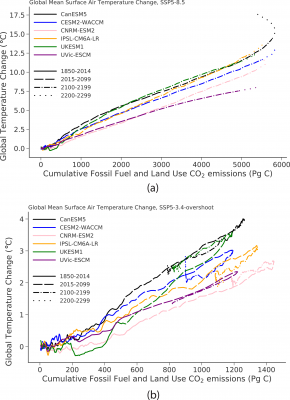Understanding long-term climate response to CO2 emissions under both very high and net-negative CO2 emissions scenarios
We analyzed the long-term dynamics of six ESMs under SSP scenarios beyond the year 2100. The goal was to better understand the coupling of climate and carbon cycles, and the relationship between warming and cumulative CO2 emissions on these longer timescales, and in particular to ask whether the proportionality between warming and cumulative emissions still holds under either very high or net negative CO2 emissions.
We find that in general, the proportionality between warming and cumulative emissions does hold even under these extreme scenarios, with some exceptions. Under both emissions, some models show lagged 23rd-century warming even after emissions stop, and on shorter timescales, there is some asymmetry under the overshoot scenario, which we show is controlled by the zero-emissions commitment (ZEC).
ESMs have typically been analyzed on dynamics before 2100. After 2100 extra possibilities arise, in whether emissions continue or possibly reverse to net negative via CDR, which may lead to differing climate and carbon dynamics on these longer timescales. We analyzed the CMIP6 models that performed long-term SSP scenarios to better understand when, where, and how model agreement holds or breaks down in climate and carbon cycle dynamics. Despite high model diversity, particularly of the terrestrial carbon cycle, we find an overall consistency in the proportionality of global warming to cumulative emissions, though with import limitations.

